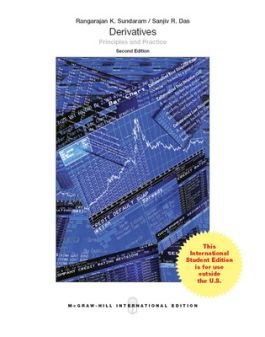DERIVATIVES
Receive via shipping:
- Colour, print bound version of the complete text
Chapter 1: Introduction
Part 1: Futures and Forwards
Chapter 2: Futures Markets
Chapter 3: Pricing Forwards and Futures I: The Basic Theory
Chapter 4: Pricing Forwards and Futures II
Chapter 5: Hedging with Futures & Forwards
Chapter 6: Interest-Rate Forwards & Futures
Part II: Equity Derivatives
Chapter 7: Options Markets
Chapter 8: Options: Payoffs & Trading Strategies
Chapter 9: No-Arbitrage Restrictions on Option Prices
Chapter 10: Early Exercise and Put-Call Parity
Chapter 11: Option Pricing: An Introduction
Chapter 12: Binomial Option Pricing
Chapter 13: Implementing the Binomial Model
Chapter 14: The Black-Scholes Model
Chapter 15: The Mathematics of Black-Scholes
Chapter 16: Options Modeling: Beyond Black-Scholes
Chapter 17: Sensitivity Analysis: The Option “Greeks”
Chapter 18: Exotic Options I: Path-Independent Options
Chapter 19: Exotic Options II: Path-Dependent Options
Chapter 20: Value-at-Risk
Chapter 21: Convertible Bonds
Chapter 22: Real Options
Part III: Swaps
Chapter 23: Interest-Rate Swaps and Floating Rate Products
Chapter 24: Equity Swaps
Chapter 25: Currency Swaps
Part IV: Interest Rate Modeling
Chapter 26: The Term Structure of Interest Rates: Concepts
Chapter 27: Estimating the Yield Curve
Chapter 28: Modeling Term Structure Movements
Chapter 29: Factor Models of the Term Structure
Chapter 30: The Heath-Jarrow-Morton and Libor Market Models
Part V: Credit Derivative Products
Chapter 31: Credit Derivative Products
Chapter 32: Structural Models of Default Risk
Chapter 33: Reduced Form Models of Default Risk
Chapter 34: Modeling Correlated Default
Part VI: Computation
Chapter 35: Derivative Pricing with Finite Differencing
Chapter 36: Derivative Pricing with Monte Carol Simulation
Chapter 37: Using Octave
Chapter 32: Structural Models of Default Risk
Chapter 33: Reduced Form Models of Default Risk
Chapter 34: Modeling Correlated Default
Part VI: Computation
Chapter 35: Derivative Pricing with Finite Differencing
Chapter 36: Derivative Pricing with Monte Carol Simulation
Chapter 37: Using Octave
Chapter 33: Reduced Form Models of Default Risk
Chapter 34: Modeling Correlated Default
Part VI: Computation
Chapter 35: Derivative Pricing with Finite Differencing
Chapter 36: Derivative Pricing with Monte Carol Simulation
Chapter 37: Using Octave
Chapter 34: Modeling Correlated Default
Part VI: Computation
Chapter 35: Derivative Pricing with Finite Differencing
Chapter 36: Derivative Pricing with Monte Carol Simulation
Chapter 37: Using Octave
Part VI: Computation
Chapter 35: Derivative Pricing with Finite Differencing
Chapter 36: Derivative Pricing with Monte Carol Simulation
Chapter 37: Using Octave
Chapter 36: Derivative Pricing with Monte Carol Simulation
Chapter 37: Using Octave
Chapter 37: Using Octave
McGraw Hill Connect is an award-winning digital teaching and learning solution that empowers students to achieve better outcomes and enables instructors to improve course management efficiency.
High-Quality Course Material
Our trusted solutions are designed to help students actively engage in course content and develop critical higher-level thinking skills while offering you the flexibility to tailor your course to the ways you teach and the ways your students learn.
Assignments & Automatic Grading
Connect features a question bank that you can select from to create homework, practice tests and quizzes. Dramatically reduce the amount of time you spend reviewing homework and grading quizzes, freeing up your valuable time to spend on teaching.
Analytics & Reporting
Monitor progress and improve focus with Connect’s visual and actionable dashboards. Reports are available to empower both instructors and students with real-time performance analytics.
Seamless Integration
Link your Learning Management with Connect for single sign-on and gradebook synchronization, with all-in-one ease for you and your students.


